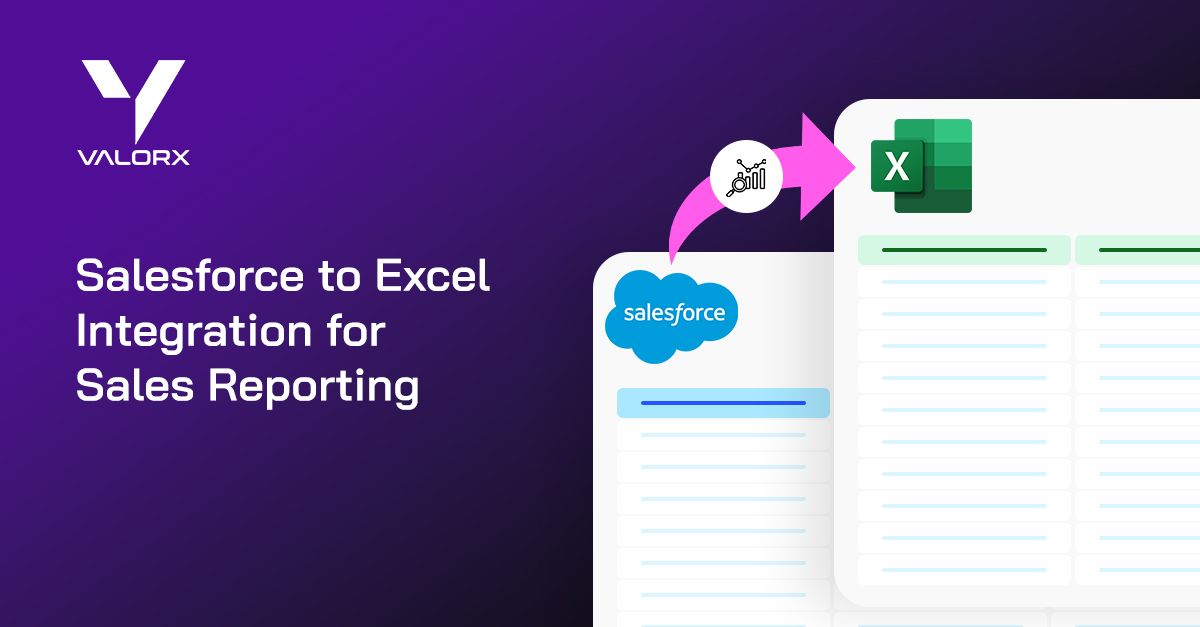Salesforce to Excel Integration for Sales Reporting
Effective sales reporting goes beyond tracking metrics - it’s central to driving strategic growth. Salesforce remains the CRM market leader with over 150,000 companies worldwide using it as the system of record. It is a major platform for sales reporting today.
However, working with Salesforce data can be difficult due to the platform’s restrictive interface.
Excel remains the most popular interface for data management and analysis, and many businesses relying on Salesforce typically manage their CRM data offline in Excel.
While posing a number of risks, this is a very common practice.
That is why the best way to get Excel-level functionality for your sales reporting in Salesforce is to use a Salesforce-to-Excel integration. Integrating Salesforce directly with Excel allows organizations to overcome usability challenges, providing a single source of truth that enhances data quality and empowers leaders to make faster, better-informed decisions.
The Importance of Real-Time, Reliable Data in Sales Reporting
The ability to quickly manage live Salesforce data strengthens an organization’s ability to respond swiftly to market shifts and emerging trends. Decision-makers avoid the delays and risks resulting from outdated information. In fact, companies working effectively with live data improve their time-to-decision by up to 33%, according to Aberdeen Group, directly impacting revenue growth and competitiveness.
Common Challenges with Managing Salesforce Data
While Salesforce is a powerful CRM, accessing and analyzing has its challenges. As a result, data is exported (or never entered into Salesforce), and managed offline in spreadsheets. In the short term this is manageable, but in the long term for any business it creates significant risks:
- Data silos: Fragmented data across platforms can lead to incomplete insights and missed growth opportunities.
- Human error/data loss: Without direct integration, exporting and updating Salesforce data in Excel can lead to errors and inefficiencies. Gartner research shows manual data handling errors cost businesses millions annually, impacting both productivity and revenue.
- Limited flexibility for reporting: While Salesforce offers reporting features, Excel’s advanced analytics capabilities, like pivot tables and scenario modeling, better support complex analyses and strategic planning as a whole.
Benefits of Integrating Salesforce with Excel
Integrating Salesforce with Excel overcomes the above obstacles. Instead, organizations are able to manage live, accurate Salesforce data and gain actionable insights plan more effectively and drive growth. Here’s why:
- Unified data views: By combining Salesforce with other data sources in Excel, businesses gain a single, complete view of sales performance. This consolidation enables leaders to analyze performance trends in real time and make precise, data-informed adjustments that support growth strategies and reduce the risk of incorrect projections.
- Enhanced forecasting and budgeting: With integrated data, finance and sales teams can work together using the same information, leading to more accurate budgeting and forecasting. Excel’s tools, such as pivot tables and formulas, enable detailed revenue projections that better align with strategic goals, reducing the potential for budgeting errors that could impact profitability.
- Advanced trend analysis and strategic planning: Integration enables more sophisticated trend tracking and risk analysis. Sales leaders can use Excel’s advanced data tools to identify patterns, predict customer demand, and assess future revenue scenarios. This level of insight supports proactive strategic planning, helping to avoid shortfalls and capitalize on growth opportunities.
Improved Sales Reporting with a Salesforce to Excel Integration
Now let’s look at how sales reporting in particular improves, by integrating Salesforce to Excel. Businesses operate more strategically in four key ways:
- Customized reporting: Leaders can tailor reports to their specific KPIs, ensuring they have the precise insights to guide strategic decisions.
- Proactive risk monitoring: Data integration enables early risk detection, allowing leadership to respond quickly and minimize revenue-impacting risks.
- Bulk data editing and enhanced collaboration: Unified data reduces duplicate entry, facilitating cross-departmental collaboration and ensuring data consistency across the organization.
- Scenario Modeling: With live Salesforce data, Excel’s modeling tools allow businesses to simulate different scenarios, aiding in strategic planning and optimizing responses to market changes.
Achieve Faster, Accurate Sales Reporting with Valorx Fusion’s Salesforce-Excel Integration
Valorx Fusion integrates Salesforce data directly with Excel, enabling teams to work with live Salesforce data in a familiar and flexible environment. Fusion enhances reporting accuracy, accelerates decision-making, and ensures consistent data across teams.
See how Valorx Fusion can streamline your organization’s reporting, optimize operational costs, and drive faster, data-informed decisions. Book a demo today to experience the benefits firsthand.

